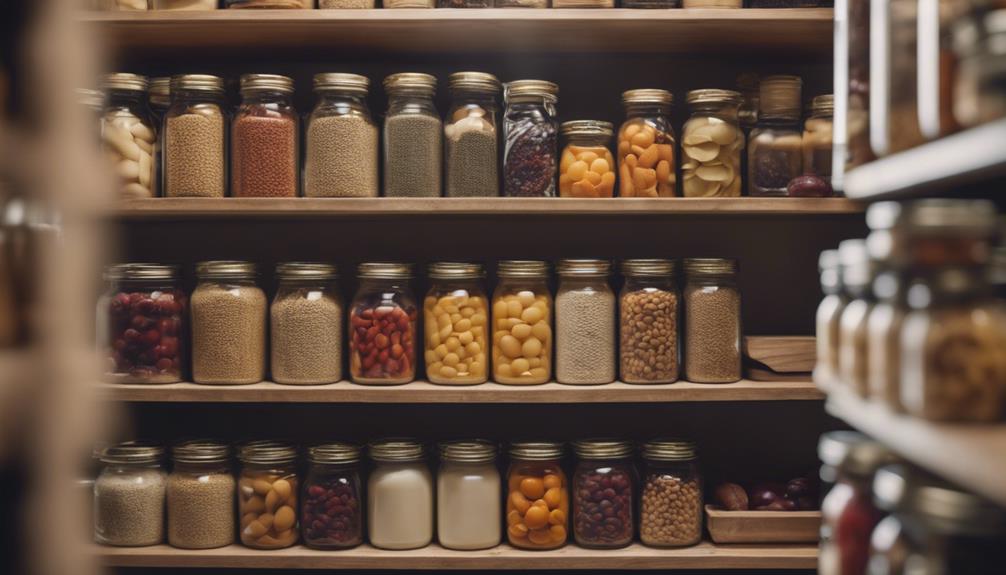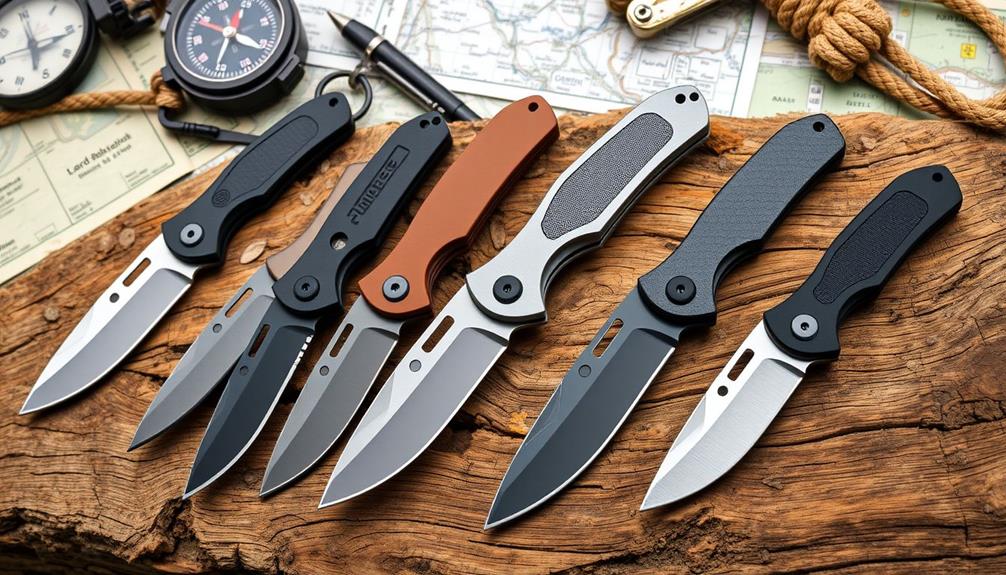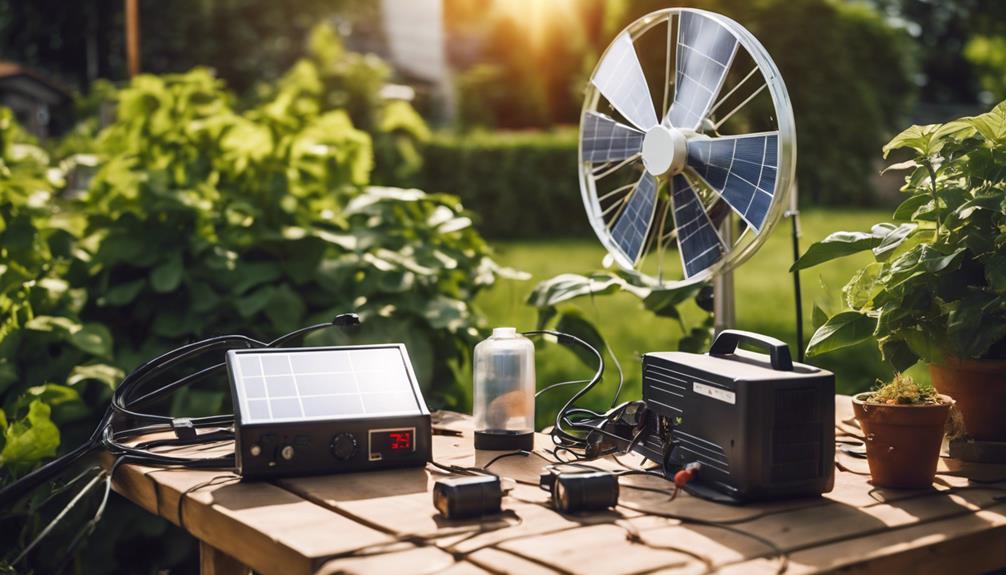To build your prepper pantry, stock up on grains, beans, canned goods, sugar, spices, and oils following the FIFO method. Guarantee longevity by sealing with Mylar bags, using oxygen absorbers, and checking expiration dates. Store water in clean containers with purification options. Organize with food-grade buckets, labels, and a pressure canner. Save money with sales, bulk buys, and DIY options prioritizing nutrition. These steps lay a strong foundation for disaster readiness and self-sustainability.
Key Takeaways
- Stock up on grains, beans, canned goods, sugar, spices, and oils for a well-rounded pantry.
- Use proper food rotation and storage techniques like Mylar bags and oxygen absorbers.
- Store water in clean containers with purification options for hydration and sanitation.
- Organize with food-grade buckets, labeling, and a pressure canner for efficient storage.
- Implement budget-friendly strategies like sales, bulk purchases, and DIY alternatives.
Pantry Staples for Preppers
Stock your pantry with essential items that will sustain you during emergencies and long-term food shortages. When it comes to long-term storage and food preservation, Costco offers a variety of pantry staples perfect for preppers. For example, you can find a 3 lb bag of salmon for $33.99, Kirkland raw honey from Michigan at $13.49, and 10 lbs of rolled oats priced at $7.99. These items are excellent for stocking up your pantry for extended periods.
Additionally, Costco provides pantry staples for cooking such as organic avocado oil (1 liter for $15.99), olive oil, and organic spices. To further enhance your prepping supplies, consider adding pasta for $7.49, organic dehydrated potatoes at $9.99, Basmati rice, and organic tomato sauces (12 cans for $11.99) to your collection.
Cost-Effective Food Storage Tips

To save money on pantry staples, consider utilizing cost-effective options such as bulk buying and seeking out sales, discounts, and coupons.
When it comes to cost-effective food storage, prioritize long-lasting options like rice, beans, and pasta. These staples aren't only affordable but also have a long shelf life, making them ideal choices for your pantry.
Look for ways to save even more by considering DIY alternatives for food preservation, such as canning or dehydrating. These methods can help you store fresh produce and extend their longevity without breaking the bank.
Additionally, opt for budget-friendly options like generic brands or store-branded items for your prepper pantry. By being strategic with your purchases and taking advantage of discounts and sales, you can build a well-stocked pantry without overspending.
Building a Long-Term Pantry

When building a long-term pantry, focus on essential pantry items that provide versatility like canned meats, grains, and cooking oils.
Organize your storage efficiently to easily access items and guarantee proper rotation and expiry management for best freshness.
These steps will help you create a well-rounded pantry ready for any situation.
Essential Pantry Items
Grains like rice, pasta, and flour are foundational items that should be prioritized when building a long-term pantry for preppers. These staples have a long shelf life and provide essential carbohydrates for sustenance.
In addition to grains, beans such as pinto, black, navy, kidney, and chickpeas offer versatility and nutrition in a pantry setup.
Canned goods are also vital for long-term storage, providing options like vegetables, fruits, and high-acid foods that can last for extended periods.
Including sugar, spices, and oils in your pantry is essential for adding flavor to meals and aiding in preservation.
To maintain freshness in your long-term storage, it's important to practice proper food rotation using the FIFO method (First In, First Out).
Storage Organization Tips
Consider utilizing unconventional storage spaces in your home to optimize the organization of your long-term pantry for preppers. Under-utilized areas like under furniture or in closets can help you build a pantry that lasts much longer.
Customize your pantry layout according to the available space and your living situation to guarantee efficient organization. It's essential to have a well-lit, easily accessible, and organized pantry to facilitate the regular rotation of supplies.
Prioritize personalized food storage options over pre-packaged ones to cater to your family's preferences and dietary needs effectively. Make sure your pantry is user-friendly by considering safety measures, proper labeling, and proximity to commonly accessed areas.
Rotation and Expiry Management
Effective management of rotation and expiry is vital for maintaining a sustainable long-term pantry for preppers. To make sure you are consuming the oldest items first and avoiding food waste, implementing a First In First Out (FIFO) system is essential. Regularly checking expiration dates on stored items is necessary to guarantee their quality and safety. Remember that different foods have varying shelf life estimates, so prioritize consumption accordingly. By reducing factors such as heat, light, moisture, pests, and oxygen in your pantry, you can prolong the shelf life of your supplies. Following safety guidelines is also critical to prevent foodborne illnesses in a long-term pantry.
| Rotation and Expiry Management Tips | Benefits |
|---|---|
| Implement FIFO system | Minimize food waste |
| Regularly check expiration dates | Ensure quality and safety |
| Prioritize consumption of items | Based on shelf life estimates |
| Reduce factors affecting shelf life | Prolong pantry supplies |
| Follow safety guidelines | Prevent foodborne illnesses |
Essential Items for Emergency Preparedness

You should prioritize understanding food shelf life, water purification methods, and emergency food kits when it comes to emergency preparedness.
Make sure to research the best ways to guarantee your food and water are safe for consumption during emergencies.
Emergency food kits can provide essential nutrients and sustenance in crisis situations.
Food Shelf Life
Understanding the shelf life of food items is essential for effective emergency preparedness, ensuring you have reliable provisions when needed most.
When it comes to stocking up on shelf-stable foods for emergency situations, it's important to take into account factors that can impact their longevity. Canned goods, for instance, can remain safe to eat well past their 'best by' date as long as the packaging remains intact.
To extend the shelf life of shelf-stable foods, employing proper storage methods like mylar bags and oxygen absorbers is key. These practices help safeguard your provisions against heat, light, moisture, pests, and oxygen, all of which can compromise their quality over time.
Selecting shelf-stable foods known for their durability and ease of preparation is essential in emergency preparedness planning. Be diligent in checking expiration dates and vigilant for any signs of botulism in canned goods to prevent foodborne illnesses during crises.
Water Purification Methods
Boiling water stands as a vital method for purifying water in emergency situations, effectively killing most pathogens at a rolling boil for one minute.
Additionally, water purification tablets like chlorine dioxide or iodine are portable and effective for emergency use.
Ultraviolet (UV) water purifiers utilize UV light to destroy microorganisms, guaranteeing the safety of drinking water.
Portable water filters, equipped with activated carbon or ceramic filters, are capable of removing bacteria and protozoa from water sources.
Distillation is another purification method involving boiling water, collecting the steam, and condensing it back into liquid form to eliminate contaminants.
When preparing for emergencies, having these water purification methods on hand is essential to ensure a safe and clean water supply.
Remember to store essential items like canned food alongside these purification tools to be fully prepared for any unforeseen circumstances.
Emergency Food Kits
When it comes to emergency preparedness, stocking up on essential items for emergency food kits is essential. Your long-term emergency food kit should include water, protein sources like peanut butter, salt, spices, staples such as rice, beans, flour, sugar, and pasta, along with canned vegetables and fruits for a balanced diet.
It's important to take into account the nutritional value, cost-effectiveness, and storage tips for each item to make sure they remain viable during emergencies.
Additionally, make sure to include batteries, fire-starting supplies, matches, and lighters in your emergency kit. Understanding the types of batteries, their costs, and the importance of fire-related items can help you build a thorough emergency preparedness kit.
Creating a Self-Sufficient Pantry

Wondering how to establish a self-sufficient pantry that can sustain you for an extended period? To guarantee your pantry is well-prepared for any situation, make sure to incorporate foods with a minimum shelf life of one year. Utilize mylar bags and oxygen absorbers for proper storage to uphold food quality and extend shelf life. Key components of a self-sufficient pantry include shelf-stable and non-perishable items like grains, beans, canned goods, fats, spices, and baking essentials. By prioritizing cost-effective options such as Costco pantry staples, you can build a sustainable and well-rounded pantry that will support you during emergencies. To guide you further, here's a breakdown of essential items to take into account for your self-sufficient pantry:
| Category | Examples |
|---|---|
| Grains | Rice, oats, quinoa |
| Beans | Black beans, lentils |
| Canned Goods | Vegetables, fruits |
| Fats | Olive oil, coconut oil |
| Baking Essentials | Flour, sugar, salt |
Top Foods for Survival Pantry

For a well-rounded survival pantry, stocking up on essential staples like grains, canned goods, beans, fats, and spices is crucial to guarantee long-term sustenance during emergencies.
When selecting items for your survival pantry, consider including the following:
- Grains: Grains like rice, pasta, and flour are must-haves due to their long shelf life and versatility in various recipes.
- Canned Goods: Incorporate canned vegetables, fruits, and high-acid foods for their extended shelf life and nutrient retention, ensuring a balanced diet during crises.
- Beans: Stock up on protein-rich beans such as pinto, black, navy, kidney, and chickpeas, known for their extended shelf life and nutritional value.
These top foods not only provide sustenance but also offer variety and essential nutrients to keep you well-fed during challenging times. By strategically including these items in your pantry, you can be better prepared for unexpected situations.
Maximizing Shelf Life of Pantry Items

To guarantee your pantry items last as long as possible, focus on proper storage techniques, rotation for freshness, and labeling for easy organization.
These simple steps can help you maintain the quality and safety of your stored foods, ultimately preparing you for any emergency situation.
Remember that a little effort now can go a long way in maximizing the shelf life of your pantry items.
Proper Storage Techniques
Maximizing the shelf life of pantry items involves utilizing proper storage techniques such as using mylar bags and oxygen absorbers. To guarantee your food supplies stay fresh and ready for consumption, consider the following:
- Seal with Mylar Bags: Seal items in mylar bags along with oxygen absorbers to create a barrier against oxygen exposure, which can lead to spoilage.
- Utilize Oxygen Absorbers: Incorporate oxygen absorbers in food-grade buckets to maintain freshness by removing oxygen, a key factor in food degradation.
- Implement FIFO Method: Practice the First In First Out (FIFO) method when organizing your pantry to use older items first, thereby reducing the risk of food waste and ensuring freshness.
Rotation for Freshness
Regularly checking expiration dates on pantry items is important for maintaining freshness and preventing waste. Implementing the FIFO (First In, First Out) system is vital to guarantee older items are used first, maximizing freshness and taste while minimizing the risk of spoilage.
By following this method, you can make things easier for yourself and reduce the chances of having expired items in your pantry. Additionally, labeling containers with purchase or expiration dates helps in tracking the age of items and facilitates easy rotation. This simple practice can aid in keeping your pantry organized and your food supply fresh.
To further extend the shelf life of pantry items, it's crucial to prevent exposure to heat, light, moisture, pests, and oxygen. Properly sealing containers and storing them in cool, dark areas can help preserve the quality and nutritional value of stored food.
Labeling and Organization
Implementing proper labeling and organization techniques in your pantry is key to maximizing the shelf life of pantry items and guaranteeing efficient inventory management. To make the most of your pantry space and keep track of your supplies effectively, consider the following tips:
- Labeling: Utilize waterproof, oil-resistant labels or markers to clearly mark item names, purchase dates, and expiration dates. This practice helps in tracking inventory and assures that you follow the first in, first out (FIFO) rotation method.
- Organization: Categorize your pantry items into sections such as grains, proteins, canned goods, and spices. This categorization not only makes it easier to locate items but also aids in managing inventory effectively.
- Grouping and Prioritizing: Store similar items together and group them by expiration dates. This way, you can easily identify which items need to be consumed first, minimizing food waste and making sure that nothing expires unnoticed.
Importance of Water in Food Storage

Water plays an essential role in food storage for preppers, serving as a critical resource for hydration, cooking, and sanitation during emergency situations. In preparing your prepper pantry, ensuring an adequate water supply is indispensable for survival.
The general guideline is to store at least one gallon of water per person per day. Proper storage is pivotal; use clean, food-grade containers stored away from direct sunlight and chemicals to prevent contamination. Rotate stored water every six months to maintain freshness, and consider using water purification tablets or filters for added safety.
Additionally, explore alternative water sources such as rainwater collection, water filtration systems, or water wells for long-term sustainability. Remember, having enough water is a top priority in your prepper food storage planning.
Organizing Your Prepper Pantry

When it comes to organizing your prepper pantry, utilizing food-grade buckets with airtight lids is key for efficient bulk storage. These containers help keep your supplies safe from pests and extend the shelf life of your emergency food stash.
Guarantee safety and easy access by labeling and stacking storage containers close to the floor. This method not only prevents accidents but also allows for a clear view of your inventory.
Consider investing in a pressure canner for versatile food preservation options. This tool can assist you in preserving a variety of foods, ensuring you have a diverse range of options in your pantry.
Tailor your pantry contents based on your family's preferences and dietary needs. By adjusting your supplies, you make sure that you have the necessary items to sustain your loved ones during an emergency.
Budget-Friendly Prepping Strategies

To save money while building your prepper pantry, consider utilizing sales, bulk purchases, and coupons for essential supplies. Starting small with a weekly budget for prepping allows you to gradually accumulate items without breaking the bank. Look for deals on key staples like water, rice, beans, and protein to maximize your savings. Additionally, consider making your own DIY alternatives to further cut costs. When selecting budget-friendly items, prioritize nutritional value and long shelf life to guarantee your pantry is well-stocked for any emergency.
| Item | Quantity | Price |
|---|---|---|
| Brown Sugar | 10 lbs | $15 |
| Canned Beans | 20 cans | $10 |
| Rice | 25 lbs | $20 |
| Protein Bars | 30 bars | $25 |
| Water Bottles | 48 bottles | $15 |
Frequently Asked Questions
How to Build a Prepper Pantry?
To build a prepper pantry, start by identifying unused spaces for storage. Customize storage solutions to fit your living situation. Keep it well-lit, organized, and easily accessible. Rotate supplies regularly for freshness. Tailor contents to your family's needs.
What Are the Best Foods to Stockpile?
When prepping, keep it simple yet essential. Stock up on versatile staples like rice and beans, add some nuts and canned meats for variety. Don't forget spices for flavor. Create a pantry that suits your needs and tastes.
What Is the Proper Food Storage Pantry?
To build a proper food storage pantry, you'll need to designate a space in your home for long-lasting emergency supplies. Make it well-organized, easily accessible, and filled with shelf-stable items that suit your family's needs.
What Is the Best Material for Long-Term Food Storage?
For long-term food storage, Mylar bags are the best choice. They block light, moisture, and oxygen, keeping your food fresh. Use oxygen absorbers to extend shelf life. Store bulk items in food-grade plastic buckets and shorter-term items in glass jars with airtight seals.
Conclusion
So there you have it, folks! With these simple tips, you can build a prepper pantry that will sustain you through any emergency.
Remember, the key to being prepared is to plan ahead and stock up on essentials.
Who knew that a little extra food storage could make all the difference when disaster strikes?
Happy prepping!










